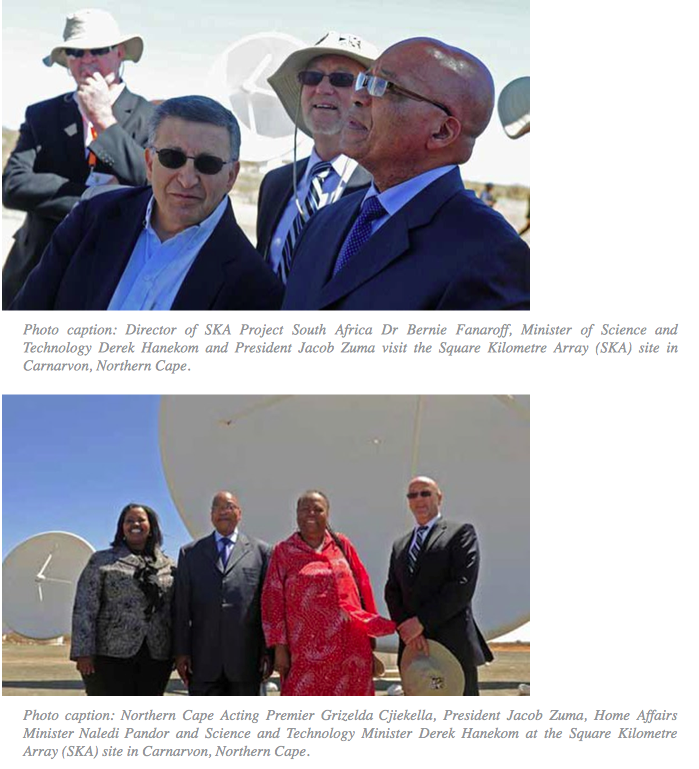SKA brightens future for Northern Cape
SKA brightens future for Northern Cape sadminBuilding a university and hosting the square kilometre array (SKA) in the Northern Cape will boost economic development in the province, President Jacob Zuma said during his visit to Carnarvon in the Northern Cape, where the SKA’s first seven telescope dishes have been erected and put into operation.
 He toured the SKA site accompanied by the newly appointed Minister of Science and Technology, Derek Hanekom, along with his predecessor who played a key role in securing the SKA bid for Africa, Minister Naledi Pandor. President Zuma said the SKA would be good for education in the province and government would invest in research, development, education and skills.
He toured the SKA site accompanied by the newly appointed Minister of Science and Technology, Derek Hanekom, along with his predecessor who played a key role in securing the SKA bid for Africa, Minister Naledi Pandor. President Zuma said the SKA would be good for education in the province and government would invest in research, development, education and skills.
“The SKA project presents an opportunity to recruit and train young South Africans intensively to pursue careers in the field of science and technology.”
President Zuma said the SKA would place Africa at the cutting edge of scientific research. “It will propel our continent to the forefront of radio astronomy and will significantly advance our continent’s scientific endeavours for many years to come. There is no doubt that through this massive project, South Africa and the continent will have much to offer the world of science and technology.”
He said the SKA project would open many doors for emerging African scientists to collaborate with some of the world’s best in the field of science and technology. “This presents an opportune moment for South Africa to add to its long and distinguished history of excellence in astronomy,” he said.
The President also disclosed plans to set up 26 science centres across the country.
“The centres are vital to the development of human capital and inculcating the culture of excellence within the field of science and technology.”
South Africa, as co-host of the SKA, is expected to become a global centre for information technology, fundamental physics, astronomy and high- tech engineering. This will lead top scientists and engineers throughout the world to visit Africa.
Following the construction of 64 dishes that will make up the MeerKAT telescope, another 190 dishes will be added during phase 1 of the SKA from 2016 to 2019.
By 2024 about 3 000 dishes will be spread across South Africa and its eight African partner countries, with about 2 000 of these at the core SKA site in the Karoo.
The core site will also host a large number of flat mid-frequency antennas, each about 60 m in diameter, the so-called fish eye lenses, used for full-sky surveys.
The first MeerKAT dish, about 13,5 m in diameter with a novel offset design will be installed by the end of 2013. The new dish design will allow the telescope to be even more sensitive.
“It was an enormous achievement for Africa to win the right to build the SKA here, but now the really challenging work starts,” SKA project director Dr Bernie Fanaroff said.
The implementation phase ahead will present us with a series of formidable challenges. This includes the extensive infrastructure, engineering and computing solutions the SKA will require.
South Africa lead the African bid to host the SKA, which includes eight fully committed partner countries: Botswana, Ghana, Kenya, Madagascar, Mauritius, Mozambique, Namibia and Zambia.
“I’m very happy to see young people speaking so confidently and passionately about the project, and already building their careers in science and technology,” President Zuma said.